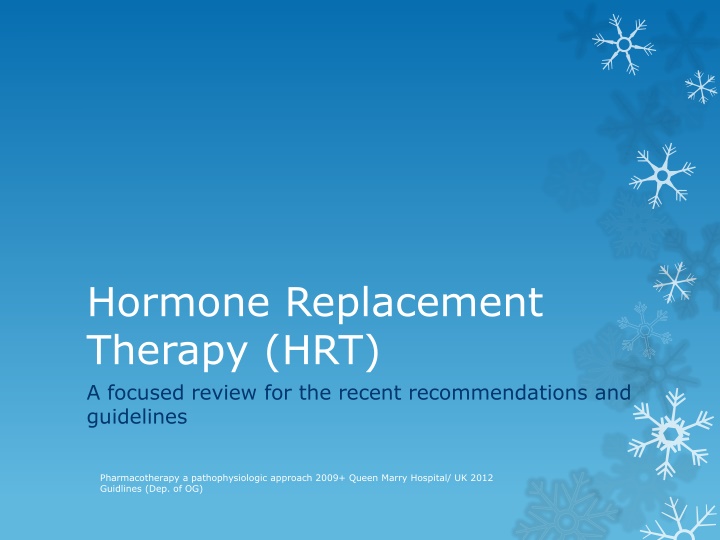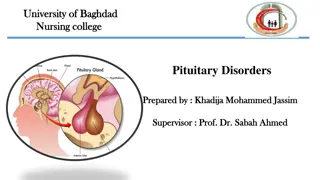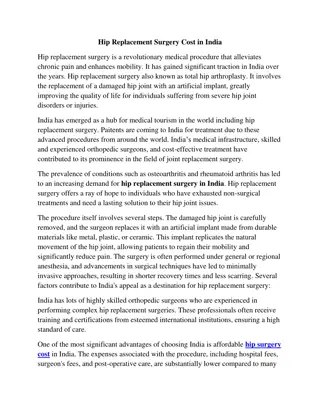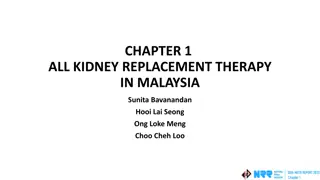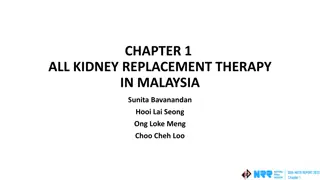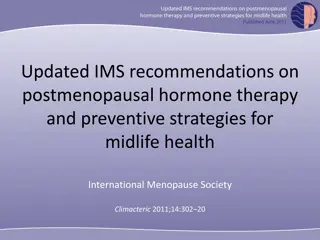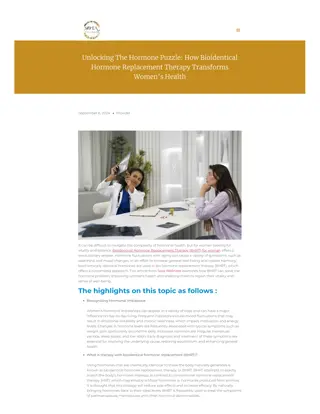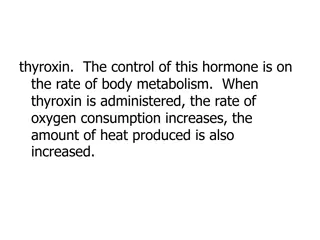Hormone Replacement Therapy (HRT): Recent Recommendations and Guidelines
Comprehensive overview of Hormone Replacement Therapy (HRT) focusing on indications for use, contraindications, estrogen and progestogen therapy guidelines, and combination regimens. Emphasizes the importance of HRT in treating menopausal symptoms and preventing osteoporosis, while highlighting potential risks and side effects associated with different therapies.
Download Presentation

Please find below an Image/Link to download the presentation.
The content on the website is provided AS IS for your information and personal use only. It may not be sold, licensed, or shared on other websites without obtaining consent from the author.If you encounter any issues during the download, it is possible that the publisher has removed the file from their server.
You are allowed to download the files provided on this website for personal or commercial use, subject to the condition that they are used lawfully. All files are the property of their respective owners.
The content on the website is provided AS IS for your information and personal use only. It may not be sold, licensed, or shared on other websites without obtaining consent from the author.
E N D
Presentation Transcript
Hormone Replacement Therapy (HRT) A focused review for the recent recommendations and guidelines Pharmacotherapy a pathophysiologic approach 2009+ Queen Marry Hospital/ UK 2012 Guidlines (Dep. of OG)
HRT at a Glance. Pharmacotherapy a pathophysiologic approach 2009+ Queen Marry Hospital/ UK 2012 Guidlines (Dep. of OG)
Approved Indications for HRT Use: Treatment of the menopausal symptoms (Short Term) Prevention of Osteoporosis (Long Term) Pharmacotherapy a pathophysiologic approach 2009+ Queen Marry Hospital/ UK 2012 Guidlines (Dep. of OG)
Contraindications: Endometrial cancer, breast cancer, undiagnosed vaginal bleeding. Coronary heart disease, thromboembolism (including recent spontaneous thrombosis or in the presence of a thrombophilia) Stroke or transient ischemic attack Active liver disease. Pharmacotherapy a pathophysiologic approach 2009+ Queen Marry Hospital/ UK 2012 Guidlines (Dep. of OG)
Estrogens: The main indication is the relief of vasomotor symptoms Variety of administration routes No evidence suggests that one product is more effective than the other ADRs include: N/V, breast tenderness, heavy bleeding, increased risk for coronary heart diseases, stroke, breast cancer, venous thromboembolism and gallstones formation. Pharmacotherapy a pathophysiologic approach 2009+ Queen Marry Hospital/ UK 2012 Guidlines (Dep. of OG)
Progestogens: Should be used for women with intact uterus to reduce the risk of endometrium hyperplasia A minimum of 12 to 14 days of progestogen therapy each month is required for complete protection against estrogen-induced endometrial hyperplasia Pharmacotherapy a pathophysiologic approach 2009+ Queen Marry Hospital/ UK 2012 Guidlines (Dep. of OG)
Estrogen and Progesterone Four combination estrogen and progestogen regimens currently in use are continuous-cyclic (sequential) ((scheduled vaginal withdrawal bleeding)) continuous-combined ( Less bleeds) continuous long-cycle (or cyclic withdrawal) ( 6 bleeds per year) Intermittent combined (or continuous-pulsed) hormone therapy Pharmacotherapy a pathophysiologic approach 2009+ Queen Marry Hospital/ UK 2012 Guidlines (Dep. of OG)
Androgens A cluster of symptoms that characterizes androgen insufficiency in women, manifested as diminished sense of well-being, persistent or unexplained fatigue, and sexual function changes such as decreased libido, decreased sexual receptivity, and decreased pleasure, has been reported. Evidence of short-term efficacy of testosterone is seen in selected populations, such as surgically menopausal women. At present, generalized use of testosterone is not recommended because the indications are inadequate, and evidence from long-term studies evaluating safety is lacking. Pharmacotherapy a pathophysiologic approach 2009+ Queen Marry Hospital/ UK 2012 Guidlines (Dep. of OG)
SERM: Selective estrogen receptor modulators (SERMs) are a group of nonsteroidal compounds that are chemically distinct from estradiol. They act as estrogen agonists in some tissues, such as bone, and as estrogen antagonists in other tissues, such as breast, through specific, high-affinity binding to the estrogen receptor. The ideal SERM would protect against osteoporosis and decrease the incidence of breast, endometrial, and colorectal cancer and coronary heart disease without exacerbating menopausal symptoms or increasing the risk of venous thromboembolism or gallbladder disease. To date, no SERM meets these ideals Pharmacotherapy a pathophysiologic approach 2009+ Queen Marry Hospital/ UK 2012 Guidlines (Dep. of OG)
SERM Tamoxifen: has estrogen antagonist activity on the breast and estrogen-like agonist activity on bone and endometrium. Raloxifene: 2nd G, available for prevention of osteoporosis. Raloxifene does not alleviate, and may even exacerbate, vasomotor symptoms. Pharmacotherapy a pathophysiologic approach 2009+ Queen Marry Hospital/ UK 2012 Guidlines (Dep. of OG)
Tibolone Tibolone is a synthetic steroid with combined estrogenic, progestogenic, and androgenic activity. Tibolone has beneficial effects on mood and libido and improves menopausal symptoms and vaginal atrophy. Tibolone protects against bone loss and reduces the risk of vertebral fractures in postmenopausal women with osteoporosis. Increases the risk for strokes. Pharmacotherapy a pathophysiologic approach 2009+ Queen Marry Hospital/ UK 2012 Guidlines (Dep. of OG)
HRT benefits Beside symptoms relief and prevention of osteoporosis: Colon Cancer Reduction (WHI study) Hormone therapy appears to have a beneficial effect on fasting glucose levels in women with elevated fasting insulin concentrations. No effect on body weight. Pharmacotherapy a pathophysiologic approach 2009+ Queen Marry Hospital/ UK 2012 Guidlines (Dep. of OG)
Cardiovascular Risk Cardiovascular Disease: recent randomized clinical trials have provided no evidence of cardiovascular disease protection and even some evidence of harm with HRT. Est.-Progest increases the CHD risks Estrogen only therapy has no CHD effects or has a favorable effects if the initiation of HRT was closer to the time of menopause. Raloxifene does not affect the risk for CHD. Pharmacotherapy a pathophysiologic approach 2009+ Queen Marry Hospital/ UK 2012 Guidlines (Dep. of OG)
Breast Cancer Est-Progest associated with increased risk of Breast Cancer Estrogen only HRT not affect the risk for BC. Raloxifene has a favorable effects in reducing the risk for BC. Pharmacotherapy a pathophysiologic approach 2009+ Queen Marry Hospital/ UK 2012 Guidlines (Dep. of OG)
Endometrial cancer With unopposed estrogen HRT the risk increased within the 1st 2 years Raloxifene is not associated with increased risks for endometrial hyperplasia Pharmacotherapy a pathophysiologic approach 2009+ Queen Marry Hospital/ UK 2012 Guidlines (Dep. of OG)
Ovarian Cancer Limited studies show the link between Ovarian Cancer and HRT, but the available data suggest that; Unopposed Estrogen regimen associated with high risk for OC and this is unlikely in the Est-Progest regimen. Pharmacotherapy a pathophysiologic approach 2009+ Queen Marry Hospital/ UK 2012 Guidlines (Dep. of OG)
VTE May be associated with any type of HRT and appear to be a dose related. Pharmacotherapy a pathophysiologic approach 2009+ Queen Marry Hospital/ UK 2012 Guidlines (Dep. of OG)
Gall bladder Disease Gallbladder disease is a commonly cited complication of oral estrogen use. Transdermal estrogen is an alternative to oral therapy for women with high risk of cholelithiasis Pharmacotherapy a pathophysiologic approach 2009+ Queen Marry Hospital/ UK 2012 Guidlines (Dep. of OG)
Dementia Reports are inconclusive, some indicate positive effects and other shows increased risks for dementia upon using HRT Pharmacotherapy a pathophysiologic approach 2009+ Queen Marry Hospital/ UK 2012 Guidlines (Dep. of OG)
Premature Ovarian Failure Premature ovarian failure is a condition characterized by sex-steroid deficiency, amenorrhea, and infertility in women younger than 40 years. The goal of therapy is to provide a hormone replacement regimen that maintains sex steroid status as effectively as the normal functioning ovary. Pharmacotherapy a pathophysiologic approach 2009+ Queen Marry Hospital/ UK 2012 Guidlines (Dep. of OG)
HRT Studies Till Now Women s Health Initiative (WHI) Women s Health Initiative Memory Study (WHIMS) Women s Health Initiative for Cognitive Aging (WHISCA) Heart and Estrogen/Progestogin Replacement Study (HERS) Women s International Study of Long Duration Oestrogen After Menopause (WISDOM) Oestrogen in the Prevention of Reinfarction Trial (ESPRIT) Estrogen Memory Study (EMS) Ultra-Low-Dose Transdermal Estrogen Assessment (ULTRA) Study of Women s Health Across Nations (SWAN) Kronos Early Estrogen Replacement Study (KEEPS) Effect of Hormone Replacement Therapy on Cardiovascular events in recently postmenopausal women Pharmacotherapy a pathophysiologic approach 2009+ Queen Marry Hospital/ UK 2012 Guidlines (Dep. of OG)
Evidence-Based Hormone Therapy Guidelines for Menopausal Symptom Management Pharmacotherapy a pathophysiologic approach 2009+ Queen Marry Hospital/ UK 2012 Guidlines (Dep. of OG)
Pharmacotherapy a pathophysiologic approach 2009+ Queen Marry Hospital/ UK 2012 Guidlines (Dep. of OG)
Individualization of therapy Because of the unlimited controversy in HRT, it should be individualized for each patient, and each case should be treated as a special one and the regimen should be tailored as such. This way, the patient will be more involved in the selection and will share the responsibility of any action. Pharmacotherapy a pathophysiologic approach 2009+ Queen Marry Hospital/ UK 2012 Guidlines (Dep. of OG)
Thanks for your attention Pharmacotherapy a pathophysiologic approach 2009+ Queen Marry Hospital/ UK 2012 Guidlines (Dep. of OG)
